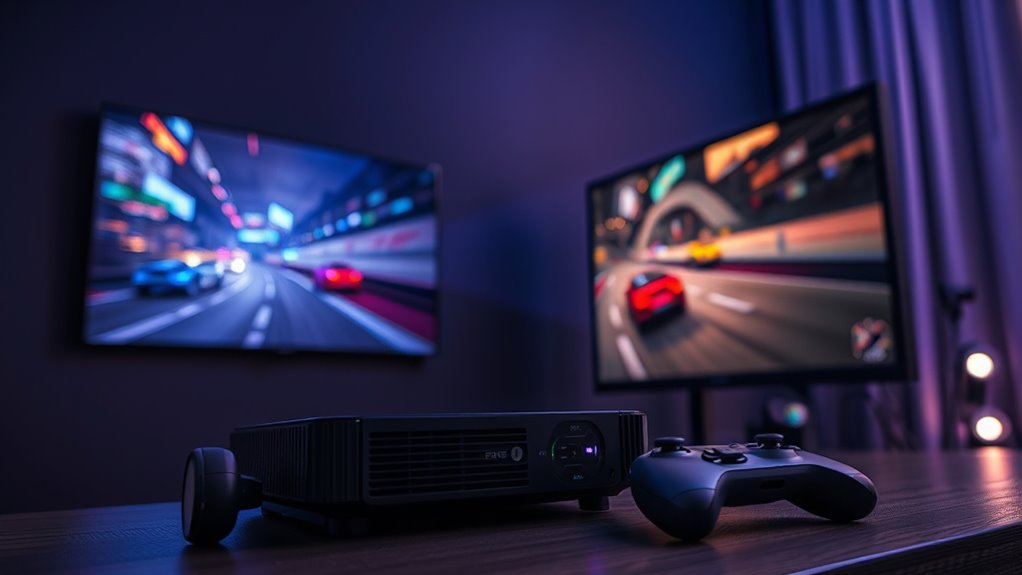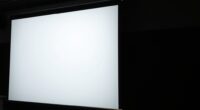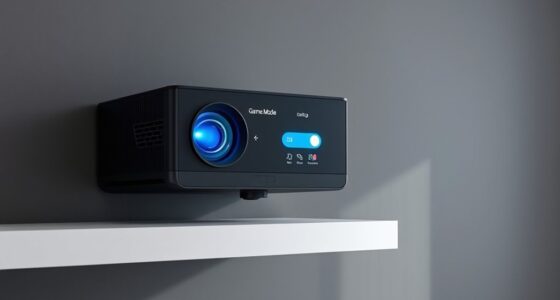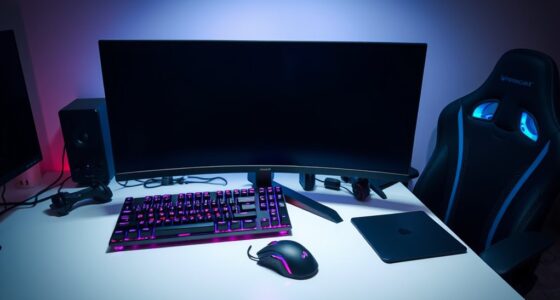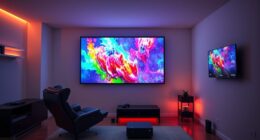Input lag is the delay between when you press a button or move the joystick and when you see the response on the screen. For gaming projectors, low input lag is vital because it guarantees your actions happen instantly, giving you a competitive edge and smoother gameplay. High lag can cause motion blur and make fast reactions frustrating. Keep exploring to discover how to choose the best projector to minimize input lag and boost your gaming experience.
Key Takeaways
- Input lag is the delay between user actions and the on-screen response, affecting gameplay responsiveness.
- High input lag can cause motion blur, ghosting, and reduced reaction times, impairing gaming performance.
- Response times and display latency are key factors influencing overall input lag in projectors.
- For competitive gaming, a projector with under 20 ms input lag is recommended for better responsiveness.
- Using game mode settings and low-latency connections helps minimize input lag for smoother gameplay.
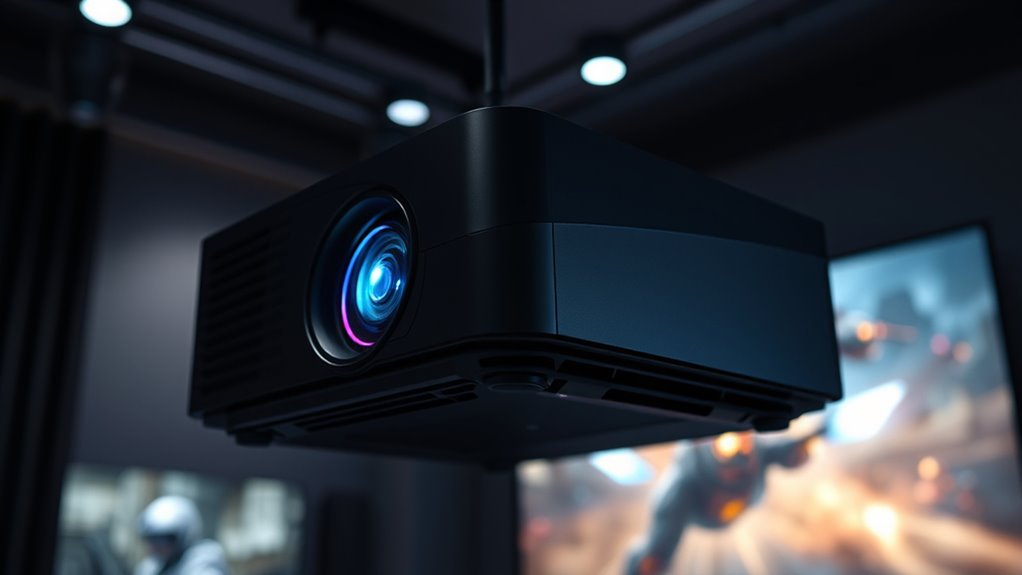
When it comes to gaming projectors, input lag is a critical factor that can make or break your experience. It’s the delay between when you execute an action—like pressing a button or moving the joystick—and when you see that action reflected on the screen. This delay is primarily influenced by response times and display latency. Response times refer to how quickly the projector’s pixels change from one color or shade to another, while display latency describes the overall delay from your input to the visual output. Both play essential roles in determining how responsive your gaming experience feels.
High response times mean that the projector’s image updates slowly, causing motion blur or ghosting effects that can distract you during fast-paced gameplay. Meanwhile, display latency adds to this delay, making it seem like your actions are happening later than they actually are. In competitive gaming or fast-action titles, even a few milliseconds of lag can hinder your performance and lead to frustration. For example, in first-person shooters or racing games, quick reflexes are indispensable, and any noticeable delay can mean the difference between winning and losing.
High response times cause motion blur, while display latency delays actions—both critical for fast-paced, competitive gaming.
Understanding response times and display latency helps you select the right gaming projector. A projector with low response times and minimal display latency ensures that your commands are executed almost instantaneously, giving you a more natural and immersive experience. When shopping, look for projectors that specify their input lag or display latency figures. Generally, a latency under 20 milliseconds is regarded as good for casual gaming, while professional or competitive players aim for 10 milliseconds or less. Keep in mind that some projectors might have a “game mode” setting, which reduces processing time and minimizes display latency, providing a smoother, more responsive feel.
It’s also important to consider the source device and connection type because these can influence response times. HDMI connections, for instance, usually support lower latency than older or less optimized interfaces. Additionally, the refresh rate and how well the projector handles fast-moving images can impact your overall experience. A projector with high response times and display latency can cause motion artifacts, making fast-moving objects appear blurry or delayed, which can be disorienting and impair your reaction times.
Frequently Asked Questions
How Does Input Lag Affect Competitive Gaming Performance?
Input lag directly impacts your competitive gaming performance by causing delays between your actions and on-screen responses. A lower refresh rate and quick response time reduce this lag, making your movements more precise and timely. When input lag is high, you might experience sluggish controls, making it harder to react quickly against opponents. To stay competitive, choose a gaming projector with minimal input lag, high refresh rates, and fast response times.
Can Low Input Lag Compensate for Lower Resolution?
Like a skilled chess player, you can think strategically about resolution trade-offs and display latency. Low input lag can indeed compensate for lower resolution, as faster response times keep your actions synchronized with the game. While a crisp image enhances immersion, quick reactions matter more in fast-paced gaming. Prioritizing low input lag helps you stay competitive, even if the resolution isn’t the highest, ensuring smooth gameplay and minimal delays.
What Are the Best Settings to Reduce Input Lag on Projectors?
To reduce input lag on projectors, start with calibration techniques like adjusting the picture mode to ‘Game’ or similar, and disable any motion smoothing features. Make sure ambient lighting is minimized, as bright lights can delay response times. Also, enable ‘Game Mode’ if available, and connect via a low-latency HDMI port. These steps help you get the best gaming experience with minimal delay.
Is Input Lag Measurement Consistent Across Different Projector Brands?
Input lag measurement isn’t always consistent across different projector brands because of varying measurement methods. You might notice that some brands report lower lag times due to different testing standards, making comparisons tricky. When shopping, look for reviews that specify measurement methods and consider brand consistency. This helps make sure you’re getting an accurate picture of a projector’s input lag, especially if you’re gaming and need precise timing.
Do All Gaming Projectors Have the Same Input Lag Specifications?
Not all gaming projectors have the same input lag specifications. Some offer very low display lag and input delay, ideal for fast-paced gaming, while others may have higher latency, which can cause noticeable delays. When choosing a projector, you should check its input lag ratings and compare models to find one that minimizes display lag, giving you a smoother and more responsive gaming experience.
Conclusion
Understanding input lag is essential if you want smooth, responsive gaming with a projector. Did you know that professional gamers aim for input lag below 20 milliseconds? Even small delays can impact your gameplay and overall experience. So, if you’re serious about gaming, choose a projector with low input lag to stay competitive and enjoy seamless action. Don’t let delays hold you back—your gaming performance depends on it.
